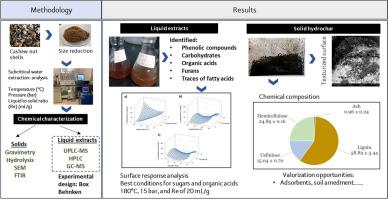利用亚临界水技术从哥伦比亚腰果(Anacardium occidentale)果壳中提取可发酵糖和酚类化合物:响应面方法和化学分析
IF 5.5
Q1 ENGINEERING, CHEMICAL
引用次数: 0
摘要
亚临界水萃取(SCWE)是一种利用高压高温水回收生物活性化合物的新型技术。腰果壳富含酚类化合物、碳水化合物和其他天然物质,虽然前景广阔,但要充分了解亚临界水萃取应用于腰果壳的潜力,还需要进一步的研究。本研究旨在采用表面响应方法对应用于哥伦比亚维查达腰果壳的 SCWE 进行评估,并对回收的提取物和剩余固体进行全面的化学分析。在研究萃取过程时采用了箱式贝肯实验设计,重点关注温度、压力和固溶比等变量。液体提取物采用超高效液相色谱法和气相色谱-质谱法进行分析,提取的固体则采用傅立叶变换红外光谱法和扫描电子显微镜进行表征。液体提取物中发现了多种化合物,包括木糖、葡萄糖、阿拉伯糖、长链酚、有机酸和呋喃。萃取条件极大地影响了这些化合物的分布,确定萃取可发酵糖和有机酸的最佳条件为 180 °C、15 巴和 20:1 mL/g 的固体与溶剂比。所得水碳由木质素(58.82 ± 3.44 %)和结构碳水化合物(约 40 %)组成,热稳定性高达 200 °C,表面有羟基官能团,显微镜下呈现纹理形态。这些副产品在各个领域都有潜在的应用价值。本研究表明,SCWE 能有效地从 CNS 中回收有价值的化合物用于发酵过程,这表明所产生的水炭可用于土壤改良、吸附或能源应用。SCWE 作为一种创新型环保技术,可用于管理腰果残余生物质,促进生产链的可持续性和循环性。本文章由计算机程序翻译,如有差异,请以英文原文为准。

Extraction of fermentable sugars and phenolic compounds from Colombian cashew (Anacardium occidentale) nut shells using subcritical water technology: Response surface methodology and chemical profiling
Subcritical water extraction (SCWE) is a novel technology that uses water at high pressure and temperature to recover bioactive compounds. While promising, further studies are needed to fully understand the potential of SCWE when applied to cashew nut shells (CNS), which are rich in phenolic compounds, carbohydrates, and other natural substances. This study aimed to evaluate SCWE applied to CNS from Vichada, Colombia, using a surface response methodology and to perform a comprehensive chemical profiling of the recovered extracts and the remaining solids. A Box-Behnken experimental design was employed to study the extraction process, focusing on variables such as temperature, pressure, and solid-to-solvent ratio. The liquid extracts were analyzed using ultra-high-performance liquid chromatography and gas chromatography coupled with mass spectrometry, while the extracted solids were characterized using Fourier-transform infrared spectroscopy and scanning electron microscopy. The liquid extracts revealed a variety of compounds, including xylose, glucose, arabinose, long-chain phenols, organic acids, and furans. Extraction conditions significantly influenced the distribution of these compounds, with the optimal conditions for extracting fermentable sugars and organic acids identified as 180 °C, 15 bar, and a 20:1 mL/g solid-to-solvent ratio. The resulting hydrochar comprised lignin (58.82 ± 3.44 %) and structural carbohydrates (approximately 40 %), showing thermal stability up to 200 °C, O![]() H functional groups on its surface, and a textured morphology under microscopy. These by-products have potential applications in various fields. This study demonstrates that SCWE effectively recovers valuable compounds from CNS for use in fermentation processes, suggesting that the resulting hydrochar could be utilized in soil amendment, adsorption, or energy applications. SCWE is highlighted as an innovative and environmentally friendly technology for managing cashew residual biomass, promoting sustainability and circularity in this production chain.
H functional groups on its surface, and a textured morphology under microscopy. These by-products have potential applications in various fields. This study demonstrates that SCWE effectively recovers valuable compounds from CNS for use in fermentation processes, suggesting that the resulting hydrochar could be utilized in soil amendment, adsorption, or energy applications. SCWE is highlighted as an innovative and environmentally friendly technology for managing cashew residual biomass, promoting sustainability and circularity in this production chain.
求助全文
通过发布文献求助,成功后即可免费获取论文全文。
去求助
来源期刊

Chemical Engineering Journal Advances
Engineering-Industrial and Manufacturing Engineering
CiteScore
8.30
自引率
0.00%
发文量
213
审稿时长
26 days
 求助内容:
求助内容: 应助结果提醒方式:
应助结果提醒方式:


